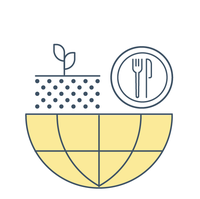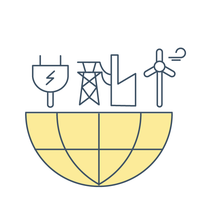 The food system
The food system
The main threats to Italian farming are climate change and the erosion of / damage to landscape ecosystems, species and genetic biodiversity, chiefly in lowland. Food systems are also a main driver of biodiversity loss: in the last 20 years, there have been slight increases in antimicrobial resistance, use of fertilisers and packaging, but slight decreases in nitrogen emissions and synthetic pesticides, which nonetheless remain high at about 5 kg/ha. These substances are found in 56% of surface water and 32% of groundwater samples.
Since 1982, the UAA has decreased by 22% due to the abandonment of rural areas and the rise of diseconomies. A major direct driver is land take for settlements, at about 6 kha/year , while the natural expansion of forests is 60 kha/year. These trends increase dependence on imports (currently at 20%, not considering feed) and increase the vulnerability of supplies. The trends are significant in cities that depend on rural areas and are also at the core of major challenges related to environmental and social impacts. Local food policies that integrate food security into priority areas aim to create more sustainable and fairer food systems.
Food culture presents opportunities for innovations in agrobiodiversity and food waste. Some regions, supported by universities and family farmers, have developed EU projects to protect local and traditional biodiversity (in Apulia, for example, about 650 crop and livestock varieties have been conserved), raising awareness of the greater nutritional value of these varieties and their resilience to ecological stresses. Organic farming continues to rise, reaching 20% of UAA and proving itself to be socioeconomically solid and ecologically effective. Systemic food wastage represents about two thirds of the calories produced. Agroecological, local, solidarity-minded and small-scale food networks prevent and reduce food waste and losses.
Through European Maritime, Fisheries and Aquaculture Fund economic incentives, Italian policies are promoting a shift towards the enhanced sustainability of the aquatic food system in terms of its primary production and value chain. In the fisheries sector, this is being done by reducing fishing effort and capacity and adopting new technologies to reduce the carbon footprint and impact on biodiversity, among other actions. The latest trends show positive outcomes, with a reduction in overexploited stock from 94% (2014) to 58% (2021) and a reduction in the average exploitation rate.
Aquaculture production in Italy, like that across the EU, is stagnating. Innovation, technological changes and sustainable growth are hampered by the complex regulatory framework and national licensing system and by increased competition to access space and water. In 2022, 0.14% of Italian marine waters were used for aquaculture, mainly for farming shellfish (94%). Two political/legislative changes will influence the aquaculture sector in the current programming period (2021–2027): (i) a new legislative framework for minimising the environmental impact of aquaculture and (ii) a sustainable aquaculture certification system, which provides a national certification for 14 farmed species.
 The energy system
The energy system
Italy’s economy is dependent on imported energy and raw materials, but in the past decade energy dependence has decreased from 83% in 2010 to 76.1% in 2023. Since 2000, the energy system has changed profoundly: natural gas increased in the early 2000s, followed, especially since 2010, by a rapid growth in renewable energy sources and a reduction in petroleum products and coal.
In the power sector, use of natural gas has increased since 1990 at the expense of oil products: in 2023, about 45% of electricity was produced from natural gas and about 4% from oil products, while in 1990 the shares were less than 20% for natural gas and nearly 50% for oil products.
The share of electricity production from renewable sources accounted for 16% in 2005. After 2007, the share increased significantly, reaching a peak of 43% in 2014. It then decreased until 2022, only to rise again, surpassing the 2014 level with a new peak in 2023 (44.3%). The annual share is quite changeable, as it depends on hydropower contributions.
Since 2001, energy consumption for electricity generation has increased at a higher rate than gross inland energy consumption. The share of electricity in final energy consumption increased from 1990, reaching 22.2% in 2023. The electrification of final consumption in industry is one of the highest in the EU-27 (39% in 2023), while in services and households it is below the EU average (48.4% versus 51.2% for services and 19.8% versus 25.9% for households). Transport shows no significant trend and a very low level (2% in 2023). Electricity in agriculture and fisheries has increased since 1990 (18.8% in 2023).
Between 2007 and 2023, the share of renewable sources in gross inland consumption more than doubled from 9% to 20.5%. Renewable gross inland consumption increased more than fourfold from 6.5 Mtoe in 1990 to 29.2 Mtoe in 2023. According to the criteria established by Directive (EU) 2018/2001, the Italian share of renewable energy sources in gross final consumption in 2023 was 19.6%.
Regarding the energy efficiency of final consumption, Italy reduced its energy consumption between 2005 and 2023 at an average rate of – 1.2% per year. Despite the downward trend, energy consumption should double this rate of decrease to achieve the 2030 targets, set in accordance with the fit for 55 and repowerEU criteria.
The government has taken encouraging initial steps to overcome the long permit-issuing procedures, administrative burdens and increasing local opposition that have delayed new renewable installations. Many resources have been dedicated in recent years, mainly aiming to develop renewables in the power sector and boost biomethane production. Further policies and measures to achieve the 2030 energy and climate targets are identified in the updated NECP, submitted to the European Commission in June 2024. The NECP aims for technological neutrality, as it anticipates the possibility of nuclear energy reaching a 22% share of electricity production by 2050 and green hydrogen being produced using renewable electricity and carbon capture and storage in hard-to-abate sectors.
 The mobility system
The mobility system
The Italian mobility system is characterised by the prevalence of road transport and the use of fossil fuels, for both passenger and freight transport. Road transport consumes more than 90% of the energy in the sector, and petrol and diesel were still the most widespread fuels in 2023. Despite some progress over the years on biofuels, electricity and the national network of charging stations and infrastructure, substantial further effort is required in the coming years. There are still regional disparities, in particular regarding infrastructure and the obsolescence of the car fleets in the south.
The number of cars per thousand inhabitants is among the highest in Europe, reaching 694 in 2023. Efforts to reduce the use of private cars, the costs of which have risen, are still hampered by the limited availability of public transport and poor accessibility of proximity services. Public transport still represents a weak point for the Italian mobility system in regard to the capillarity of the service, regularity and speed of travel, rigidity of local public transport pricing systems and average age and emission profile of buses and trains (despite some progress in fleet renewal). High-speed rail passenger transport, on the other hand, increased by 5% between 2019 and the third quarter of 2024.
The opportunities related to IT devices have not yet been exploited extensively for the mobility system. Administrative policies have achieved some progress but have so far been inadequate in increasing demand for low-impact modes of transport, particularly concerning restrictions on private traffic through low-emission zones, road and park pricing and the promotion of active mobility through pedestrian areas and cycle lanes.
Focus should be on mobility as a service by better promoting shared and sustainable mobility and the pay-per-use model, which is particularly advantageous for electric vehicles used for urban trips.
Cycling and micromobility solutions have increased recently, and Italy hopes to mitigate transport challenges through the full implementation of the 2022–2024 general plan for cycling mobility. Specific interventions and resources are recommended in implementation plans for the 2030 national road safety plan. These plans take into account the major risk factors based on accident analyses and consider provision of education on safety through training projects, especially in schools.
Policies and measures to achieve the 2030 energy and climate targets are identified in the NECP. Recently, resources have been dedicated to the modernisation and development of the transport sector on the basis of the national recovery and resilience plan and the complementary national plan, to which other funds from national and European sources have been added. The framework of guidelines and policies has also been strengthened recently. Sustainable urban mobility plans have provided means for improving the urban mobility of people and goods.

